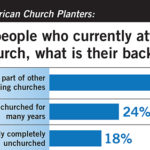NASHVILLE, Tenn. (ABP)—Many churches and denominations put a lot of effort into attracting new members only to lose many of them through a “back door”—a term used to describe people who regularly attended a church in the past but stopped.
“Churches have gone to great extreme effort to get people in the front door of the church,” Brad Waggoner of LifeWay Christian Resources said in a 2006 podcast. “There’s been some success numerically in that strategy, but very few people are talking about the back door of the church. That is: ‘Where do the people go that slip out of the life of the church?’
“The back door is just as important as the front door in determining the health of a local church.”
LifeWay President Thom Rainer described in an article on ChurchLeaders.com a meeting with more than 200 church leaders where nearly 90 percent indicated their churches had a problem with closing the back door.
“For years, the primary focus in many churches has been on the ‘front door’—people coming into the church,” Rainer said. “While such an emphasis remains the Great Commission priority, our research shows that churches and their leaders must not neglect the issue of the back door, commonly called assimilation.”
George Bullard of The Columbia Partnership, a Columbia, S.C.-based organization that helps churches pursue and sustain vital ministry, said churches face an “assimilation challenge” in the first year after new people begin attending to influence whether they become part of a community or slip through the back door.
“Church growth is a pretty simple concept,” Bullard said. “You get more people who have not been regular attendees and members to become regular attendees and members. You get more regular attendees and members to deepen their involvement in their church and its disciple-making activities. You get less-regular attendees and members to become bored, apathetic or offended and leave the church. If the second thing does not happen, the third thing is likely to happen.”
Mike James, discipleship and assimilation coordinator for the Kentucky Baptist Convention, said in a blog that assimilation is the difference between a church that is like Velcro—where people stick—or Teflon—where people join but stop attending.
Every church should have a strategy for getting first-time visitors to return and a follow-up plan to get them back a second time, James said. It begins by placing value on guests. “Scripture tells us to be warm and friendly to the people we meet,” he said.
Sign up for our weekly edition and get all our headlines in your inbox on Thursdays
James recommends treating every person like he or she is a guest. “Even your own members need a good welcome and a warm greeting,” he said.
The simplest and most effective way to attract guests is to invite them, James said. Polls show that between 75 percent and 90 percent attend church because a friend or relative invited them.
“Churches must be intentional in this process, or we become a revolving door with as many people going out the back door as we have coming through the front door,” James said.
Four things need to happen within the first year for people to assimilate into a new church, Bullard said.
• Make attendance a habit.
First, he said, they must have established a pattern of regular attendance. By today’s standards, “in a culture that no longer sits around on Sundays,” Bullard said, regular attendance is between 39 and 42 Sundays a year.
Research indicates the American church went through a period of more than 10 years when churches significantly lowered their expectations of members and attendees, Rainer said. The result was an exodus of people from the church.

|
“Why would I want to be a part of something that expects nothing of me?” Rainer quoted a former active church member talking to the research team. Many churches now are attempting to remedy the problem with new-member classes, where expectations of service, stewardship and attendance are clearly established.
Common names for such classes are “Connections,” “Membership 101” or “Discovery,” James noted.
“Give it any name you desire, but by all means start one,” he said.
• Get connected.
Second, Bullard said, they must have connected with some kind of teaching/learning experience such as a small group or Sunday school class.
“Churches that close the back door seek to get as many of their members as possible into small groups,” Waggoner said. “In some churches, these groups meet in homes. In other churches, the small group is a Sunday school class that meets at the church. The key issue, according to our research, is that the small group is an open group, meaning it has no predetermined termination date, and anyone can enter the group at any point.”
• Develop deep relationships.
Third, Bullard said, they need to have developed friends “they call at 3 a.m.,” a reference to Hillary Clinton’s presidential campaign national-security ad featuring a ringing phone in the White House at 3 a.m. and posing a question to voters about who they want answering the phone.
Win Arn, a pioneer in church growth, showed years ago that if somebody can make five friends at a church, they are must less likely to drop out, Waggoner noted. “We need to create opportunities for people to build friendships and to get to know folks,” Waggoner said. “Just sitting in the pew is never God’s intention for any Christian.”
The more new members connect with longer-term members, the greater the opportunity for assimilation, Rainer said. One twist the research found, he said, is that most such relationships develop before the new member ever comes to church. In other words, members first developed relationships with people outside the walls of the church and then invited them after the relationship was established.
• Go to work.
Finally, Bullard said, they need to get “some kind of job,” whether elected, appointed or as an ongoing volunteer.
“There’s no doubt about it that when you involve people in the ministries of the church, they are much more likely to give and much more likely to stay,” Waggoner agreed. “If they’re just pew sitters, they are more vulnerable to become disillusioned, and we’ll lose some of the people”
The earlier a new member or attendee can get involved in a church’s ministries, the higher the likelihood of effective assimilation, Waggoner said. “Churches that close the back door have a clear plan to get people involved and doing ministry as quickly as possible.”
“If people don’t do those four things, at the end of their first year, they are going to re-evaluate whether they want to stay in this church,” Bullard said.
While not a primary motivation for assimilating new people, Bullard added, an “unintended consequence” is that people who buy into the church with their time give five times more money than those who do not invest their time and energy.














We seek to connect God’s story and God’s people around the world. To learn more about God’s story, click here.
Send comments and feedback to Eric Black, our editor. For comments to be published, please specify “letter to the editor.” Maximum length for publication is 300 words.